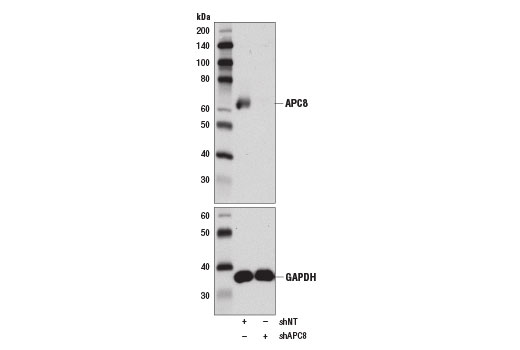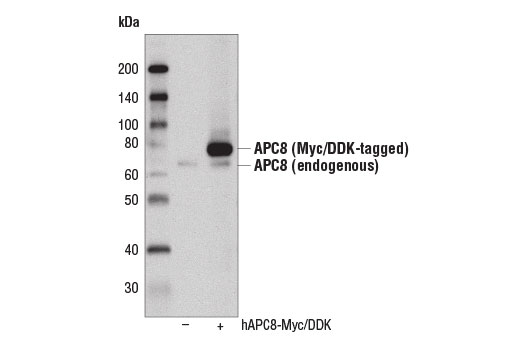


1/3
产品介绍
产品信息
分子量
64

背景
背景
Eukaryotic cell proliferation depends strictly upon the E3 ubiquitin ligase activity of the anaphase promoting complex/cyclosome (APC/C), whose main function is to trigger the transition of the cell cycle from metaphase to anaphase. The APC/C complex promotes the assembly of polyubiquitin chains on substrate proteins in order to target these proteins for degradation by the 26S proteasome (1,2). The vertebrate APC/C complex consists of as many as 15 subunits, including multiple scaffold proteins, two catalytic subunits (APC2, APC11), and a number of proteins responsible for substrate recognition (3). All E3 enzymes, including APC/C, utilize ubiquitin residues activated by E1 enzymes and transferred to E2 enzymes. Research studies indicate that APC/C interacts with the E2 enzymes UBE2S and UBE2C via the RING-finger domain-containing subunit APC11 (4-6). APC/C function relies on multiple cofactors, including an APC/C coactivator formed by the cell division control protein 20 homolog (CDC20) and Cdh1/FZR1. The CDC20/Cdh1 coactivator is responsible for recognition of APC/C substrates through interaction with specific D-box and KEN-box recognition elements within these substrates (7-9).Anaphase-promoting complex subunit 8 (APC8, CDC23) is a component of the tetratricopeptide repeat (TPR) APC/C sub-complex that also includes APC3 (CDC27) and APC6 (CDC16). APC8 protein associates with APC3 and APC6 to facilitate recruitment of the APC/C coactivation subunits CDC20 and Cdh1/FZR1 (10,11). Research studies suggest that APC8 protein is overexpressed in papillary thyroid cancer and acts as an important regulator of cell cycle progression and cell growth (12).
1.Qiao, X. et al. (2010) Cell Cycle 9, 3904-12.
2.Harper, J.W. et al. (2002) Genes Dev 16, 2179-206.
3.Chang, L. et al. (2014) Nature 513, 388-93.
4.Carroll, C.W. and Morgan, D.O. (2002) Nat Cell Biol 4, 880-7.
5.Gmachl, M. et al. (2000) Proc Natl Acad Sci U S A 97, 8973-8.
6.Leverson, J.D. et al. (2000) Mol Biol Cell 11, 2315-25.
7.Kraft, C. et al. (2005) Mol Cell 18, 543-53.
8.Glotzer, M. et al. (1991) Nature 349, 132-8.
9.Pfleger, C.M. and Kirschner, M.W. (2000) Genes Dev 14, 655-65.
10.Matyskiela, M.E. and Morgan, D.O. (2009) Mol Cell 34, 68-80.
11.Thornton, B.R. et al. (2006) Genes Dev 20, 449-60.
12.Zhang, L. et al. (2011) Endocr Relat Cancer 18, 731-42.

研究领域
细胞生物学
声明 :本官网所有报价均为常温或者蓝冰运输价格,如有产品需要干冰运输,需另外加收干冰运输费。








 用小程序,查商品更便捷
用小程序,查商品更便捷







 危险品化学品经营许可证(不带存储) 许可证编号:沪(杨)应急管危经许[2022]202944(QY)
危险品化学品经营许可证(不带存储) 许可证编号:沪(杨)应急管危经许[2022]202944(QY)  营业执照(三证合一)
营业执照(三证合一)